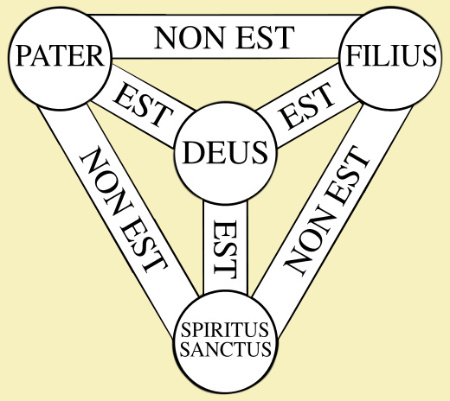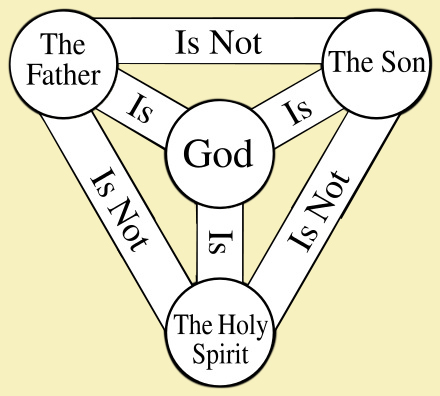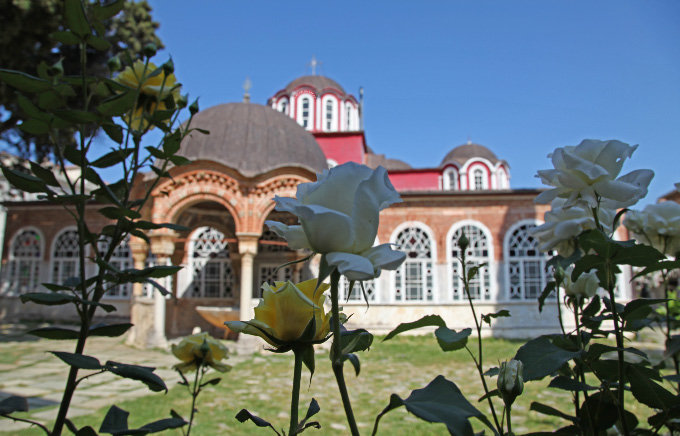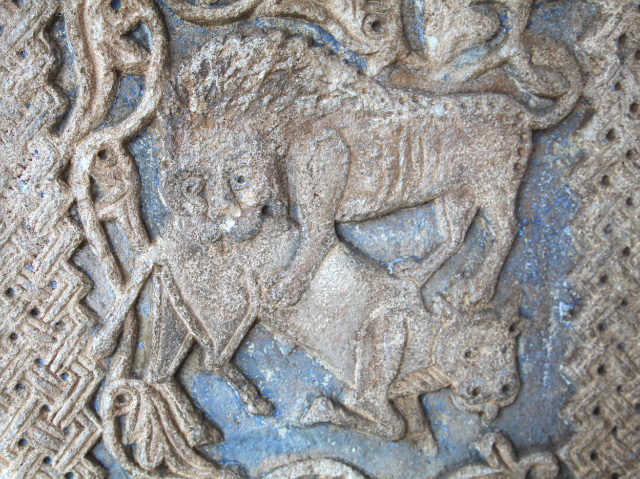|
Η Πρώτη Οικουμενική Σύνοδος, η Πρώτη Σύνοδος της Νίκαιας
Synodus Prima Oecumenica, Concilium Nicaenum Primum
The First Ecumenical Council, the First Council of Nicea
Первый Вселенский Собор, Первый Никейский Собор
The Council of the 318 Church Fathers assembled in Nicea, perhaps from 20 May through 25 August, in the Year of Our Lord 325
|
|
|
| |
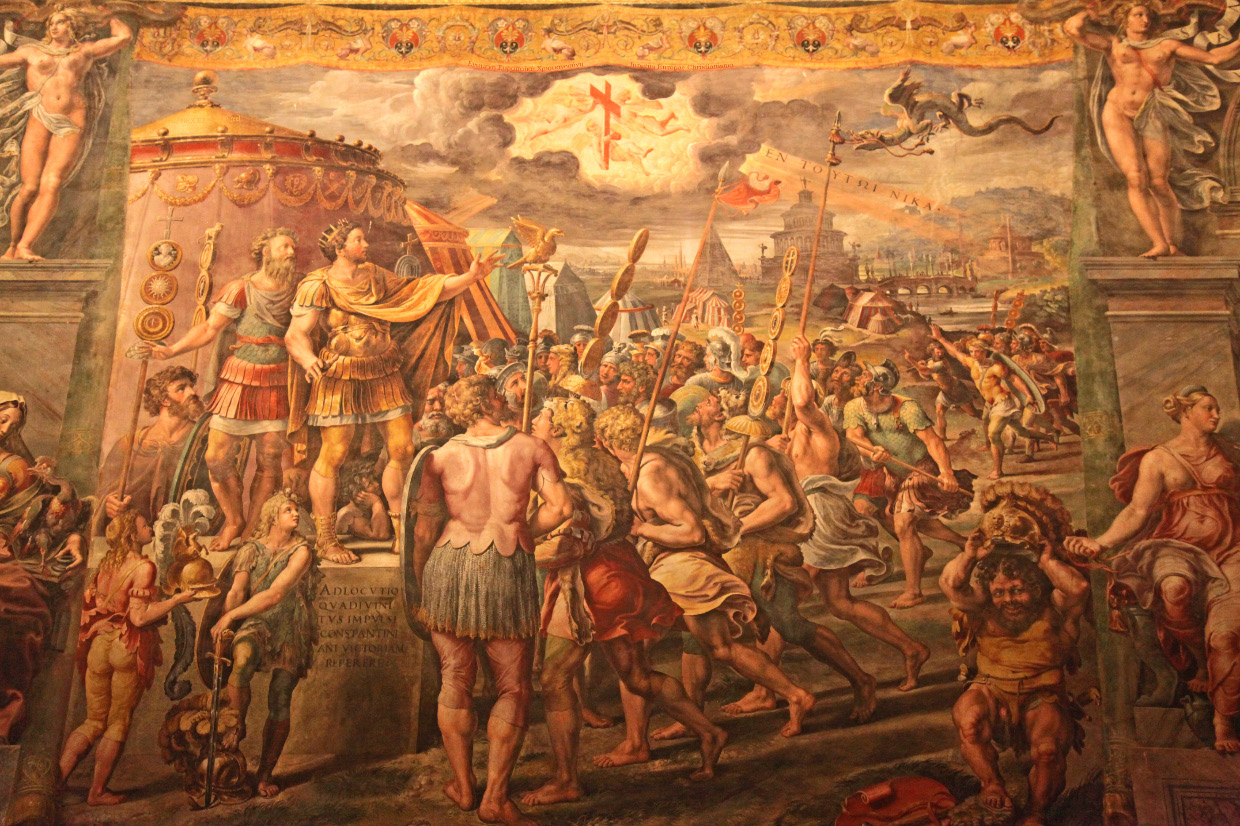 |
|
| |
Ἐν Τούτῳ Νίκα – In hoc signo vinces – In this sign you will conquer |
|
| |
Visione della Croce – Vision of the Cross |
|
| |
| La Visione della Croce, affresco nella Sala di Costantino entro le Stanze di Raffaello del Palazzo Vaticano, 1520-1524 dagli assistenti di Raffaello Sanzio da Urbino, Raffaellino del Colle, Gianfrancesco Penni e Giulio Romano. |
| |
| The Vision of the Cross, fresco in the Hall of Constantine within the Raphael Rooms of the Vatican Palace, 1520-1524 by assistants of Raffaello Sanzio da Urbino, Raffaellino del Colle, Gianfrancesco Penni and Giulio Romano. |
|
|
|
Emperor Saint Constantine the Great - Flavius Valerius Aurelius Constantinus Augustus (*27 February 272 – 22 May 337†) |
|
| |
|
|
| |
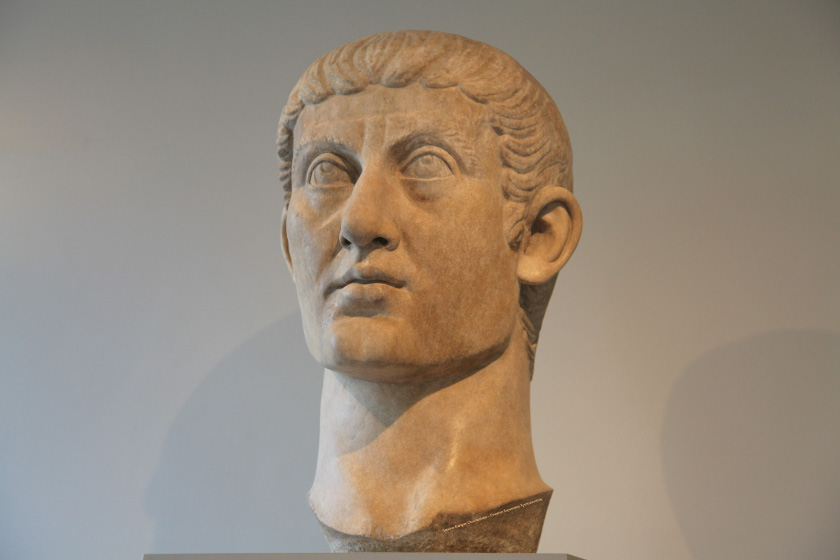 |
|
| |
|
|
| |
This work in the Meteropolitan Musuem of Art in New York is of more than ususal interest, as it is believed to date from the late period of Constantine's life, or in any case from before 370 Anno Domini, so, unlike so many other such works, the sculptor may have seen the Emperor personally, making this a real portrait of his likeness. |
|
| |
|
|
|
| |
Next, I may reasonably turn to those who divide and cut to pieces and destroy that most sacred doctrine of the Church of God, the Divine Monarchy, making it as it were three powers and partitive subsistences and god-heads three. I am told that some among you who are catechists and teachers of the Divine Word, take the lead in this tenet, who are diametrically opposed, so to speak, to Sabellius’s opinions; for he blasphemously says that the Son is the Father, and the Father the Son, but they in some sort preach three Gods, as dividing the sacred Monad into three subsistences foreign to each other and utterly separate. For it must needs be that with the God of the Universe, the Divine Word is united, and the Holy Ghost must repose and habitate in God; thus in one as in a summit, I mean the God of the Universe, must the Divine Triad be gathered up and brought together. For it is the doctrine of the presumptuous Marcion, to sever and divide the Divine Monarchy into three origins,—a devil’s teaching, not that of Christ’s true disciples and lovers of the Saviour’s lessons. For they know well that a Triad is preached by divine Scripture, but that neither Old Testament nor New preaches three Gods.
Equally must one censure those who hold the Son to be a work, and consider that the Lord has come into being, as one of things which really came to be; whereas the divine oracles witness to a generation suitable to Him and becoming, but not to any fashioning or making. A blasphemy then is it, not ordinary, but even the highest, to say that the Lord is in any sort a handiwork. For if He came to be Son, once He was not; but He was always, if (that is) He be in the Father, as He says Himself, and if the Christ be Word and Wisdom and Power (which, as ye know, divine Scripture says), and these attributes be powers of God. If then the Son came into being, once these attributes were not; consequently there was a time, when God was without them; which is most absurd. And why say more on these points to you, men full of the Spirit and well aware of the absurdities which come to view from saying that the Son is a work? Not attending, as I consider, to this circumstance, the authors of this opinion have entirely missed the truth, in explaining, contrary to the sense of divine and prophetic Scripture in the passage, the words, ‘The Lord created me a beginning of His ways unto His works.’ For the sense of ‘He created,’ as ye know, is not one, for we must understand ‘He created’ in this place, as ‘He set over the works made by Him,’ that is, ‘made by the Son Himself.’ And ‘He created’ here must not be taken for ‘made,’ for creating differs from making. ‘Is not He thy Father that hath bought thee? hath He not made thee and created thee?’ says Moses in his great song in Deuteronomy. And one may say to them, O reckless men, is He a work, who is ‘the First-born of every creature, who is born from the womb before the morning star,’ who said, as Wisdom, ‘Before all the hills He begets me?’ And in many passages of the divine oracles is the Son said to have been generated, but nowhere to have come into being; which manifestly convicts those of misconception about the Lord’s generation, who presume to call His divine and ineffable generation a making.
Neither then may we divide into three Godheads the wonderful and divine Monad; nor disparage with the name of ‘work’ the dignity and exceeding majesty of the Lord; but we must believe in God the Father Almighty, and in Christ Jesus His Son, and in the Holy Ghost, and hold that to the God of the universe the Word is united. For ‘I,’ says He, ‘and the Father are one;’ and, ‘I in the Father and the Father in Me.’ For thus both the Divine Triad, and the holy preaching of the Monarchy, will be preserved. |
|
| |
|
Letter of Pope Saint Dionysius (reigned from 22 July 259 to 26 December 268 †) to Saint Dionysius the Great of Alexandria, (reigned as 14th Pope of Alexandria & Patriarch of the See of Saint Mark from 28 December 248 until 22 March 264 †). [emphasis added] |
|
| |
|
|
|
| |
But of course, this important letter from a (later canonized) pope to the, also canonized, predecessor of Saint Athanasius, that is, to Saint Dionysius the Great of Alexandria, did not in the event preempt the very calling and coming into being of the First Ecumenical Council, the Council of Nicea, which was called by Emperor Constantine in 325 Anno Domini, nearly seven decades after Pope Saint Dionysius' letter, largely to deal with the same matters Pope Dionysius had written on, as such had again emerged, this time in the erroneous teachings of Heresiarch Ἄρειος – Arius (circa 256 to 336).
Is this circumstance one huge piece of evidence that Roma locuta est, causa finita est — Rome has spoken, the case is closed was not the maxim of the Church Fathers closest in time to the Earthly Ministry of Christ Jesus, God the Son, and to Christ's speaking into existence of the canon law of the Biblical Petrine Verses? These Church Fathers, individually and gathered in council, gave great deference to Peter's successors, but were the popes seen as one-man ecumenical councils, empowered by the Holy Spirit to resolve infallibly the major theological disputes which emerged? |
|
|
| |
|
|
|
|
|
|
| |
Athanasius Contra Mundum – Athanasius Against the World – Ο Αθανάσιος εναντίον του κόσμου |
|
| |
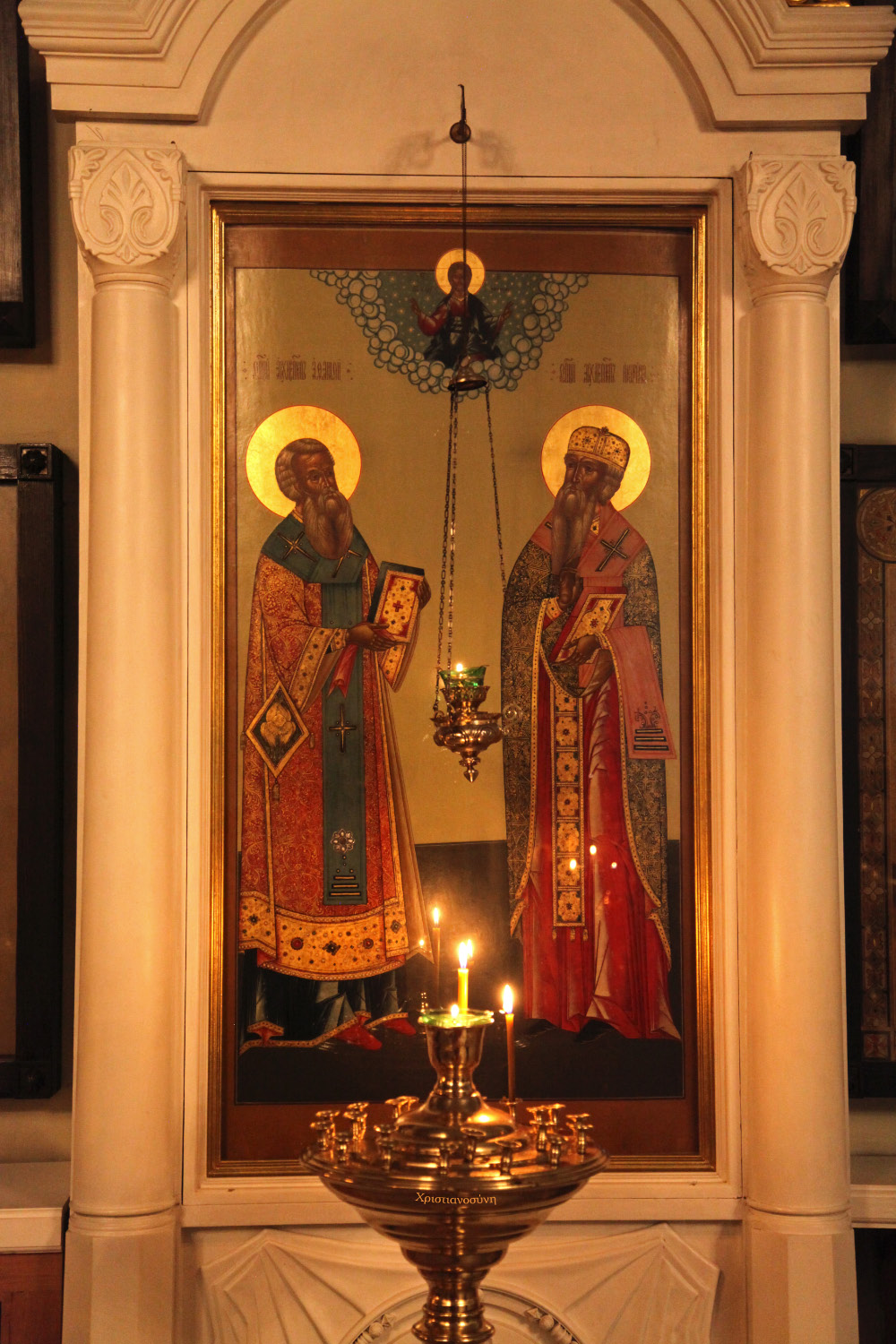 |
|
| |
Ἀθανάσιος Ἀλεξανδρείας – Saint Athanasius – Афанасий Великий, Confessor and Doctor of the Church,
*born c. 296-8; Patriarch of Alexandria from 328; reposed in the Lord 2 May 373†
Κύριλλος Ἀλεξανδρείας – Saint Cyril (Kirill) of Alexandria – Кирилл Александрийский, Doctor of the Church
*born c. 376; Patriarch of Alexandria from 412; reposed in the Lord 27 June 444†
Icon in the Храм Святителей Афанасия и Кирилла, патриархов Александрийских, на Сивцевом Вражке, Moscow |
|
| |
|
|
|
| |
Osius Cordubensis – Osio de Córdoba – Όσιος Κορδούης – Осий Кордубский – Hosius of Cordoba – (* c. 256, Bishop of Córdoba from 295 – Serbia 357 †), preeminent Church leader of his time and the leader of the First Ecumenical Council, the Council of Nicea. Bishop Hosius of Córdoba wrote a letter in 353 to Emperor Constantius II, who, along with two brothers, Constantine II and Constans, succeeded his father, Constantine the Great, on 22 May 337, eventually becoming and reigning as sole Augustus from 350 until his death on 3 November 361. This letter, recall, only 40 years after Constantine the Great's Edict of Milan, protested imperial interference in Church affairs. |
|
|
| |
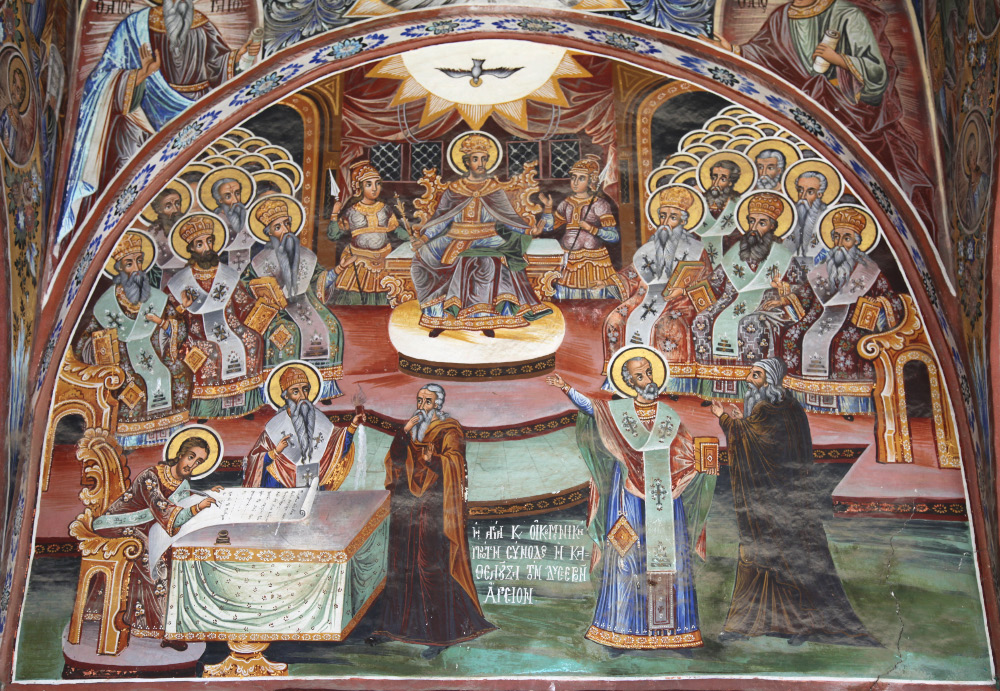 |
|
| |
Fresco depicting the First Ecumenical Council in the narthex of the Church of Saint Athanasius the Athonite
in the Great Lavra on Holy Mount Athos - Μονή Μεγίστης Λαύρας του Άγιο Όρος Άθως
|
|
| The Orthodox, or if one will, the Catholic Trinitarian Christology |
|
|
|
|
|
| |
|
|
|
|
|
|
| |
ὁμοούσιος – Homoousian |
|
|
|
|
|
| |
|
|
|
|
|
|
| |
ὁμός – homós – "same" + οὐσία – Ousia – "being" |
|
(Ousia is sometimes rendered in Latin as substantia or essentia, in English as substance or essence) |
|
|
|
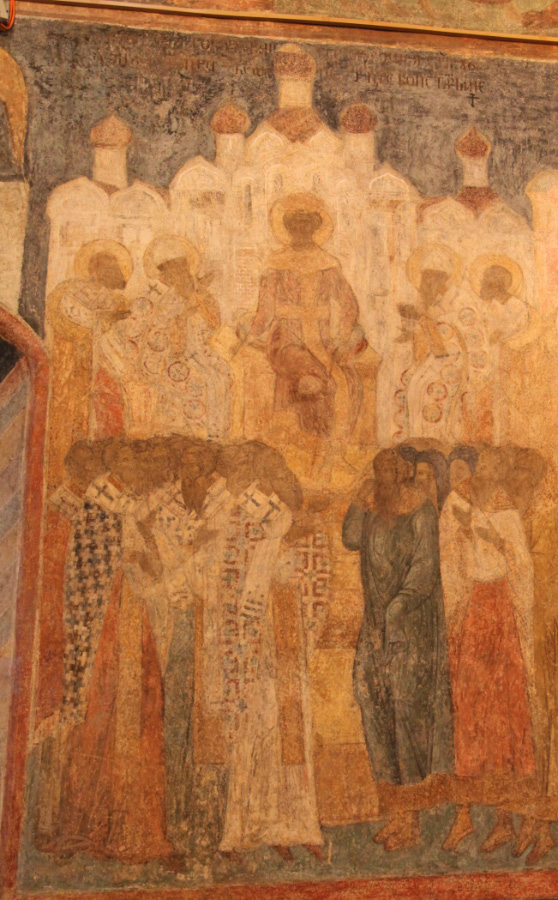 |
|
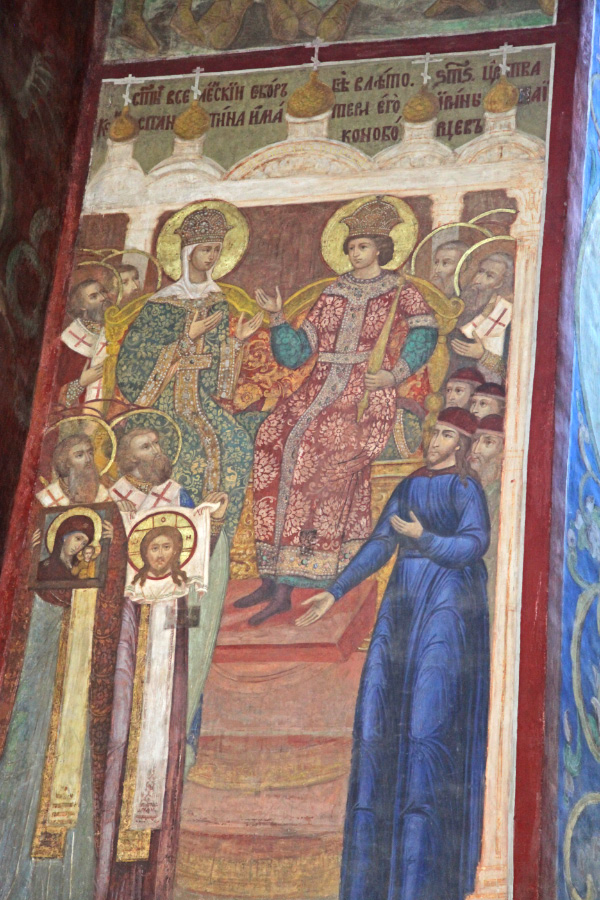 |
Fresco (1563-1564) in the Transfiguration of the Savior Cathedral (built 1506-1516) within
the Transfiguration of the Savior Monastery (founded XII century) in Yaroslavl –
Спасо-Преображенский Собор (1506-1516 гг.) в Спасо-Преображенском
Монастыре (основан в XII веке) в Ярославле. |
|
Icon written in fresco in the 17th century in Успенский Собор –
Cathedral of the Dormition/Assumption, built 1559-1585, in the
Свято-Троицкая Сергиева Лавра в Сергиевом Посаде
– Holy Trinity Lavra of Saint Sergius in Sergiev Posad.
|
|
|
|
| |
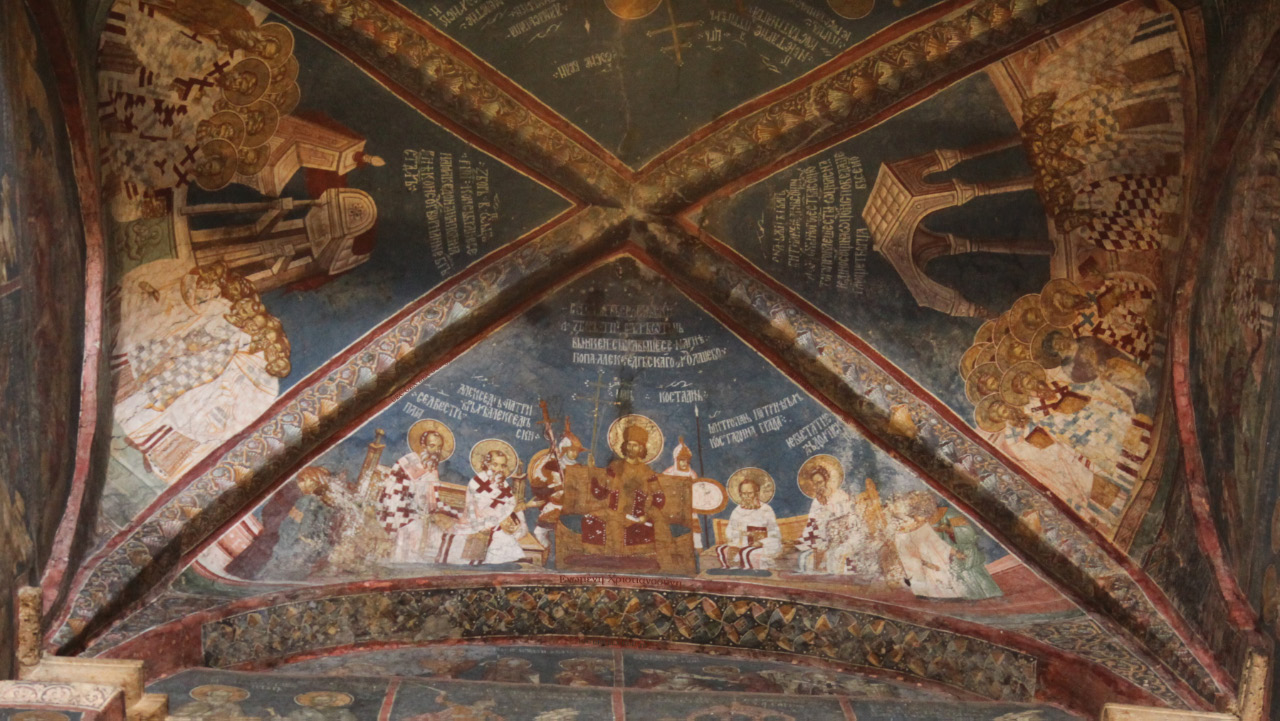 |
|
| |
In the central nave of the narthex in Манастир Високи Дечани Метохије Косова и Метохије – the Visoki Dečani Monastery in the Metohija region of Kosovo and Metohija, constructed 1327 to 1335 under the direction of a Catholic Franciscan monk from Kotor in Montenegro – Fra Vita фра Вита из Котора. The interior frescos were finished shortly thereafter, around the year 1350 Anno Domini. A glorious tribute to the Orthodox-Catholic Church and to European Christendom. Picture from 28 XII 2012. Within the pictured ceiling cross vault the First Ecumenical Council, the Council of Nicea of 325 Anno Domini is twice depicted. In the wide panel in the lower section of this picture are depicted Emperor Constantine and Four Holy Bishops - Alexander, Patriarch of Alexandria, Sylvester, Pope of Rome, Metrophanes, Patriarch of Constantinople, and Eustathius, Patriarch of Antioch (Цар Константин и четири света архијереја - Александар, патријарх александријски, Силвестер, папа римски, Митрофан, патријарх цариградски, и Јевстатије, патријарх антиохијски). Then to the right in this picture and tilted ninety degrees to the viewer's left, the composition in this panel depicts Orthodox Church Fathers (with haloes) and Heretics (obviously without) (Први васељенски сабор - Правоверни оци и јеретици). |
|
| Rise, and have no fear. |
|
This is my beloved Son, with whom I am well pleased; listen to him. |
the Holy Spirit |
Man proposes, God disposes |
|



